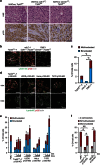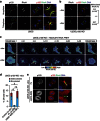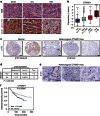p120-catenin prevents multinucleation through control of MKLP1-dependent RhoA activity during cytokinesis
- PMID: 28004812
- PMCID: PMC5192218
- DOI: 10.1038/ncomms13874
p120-catenin prevents multinucleation through control of MKLP1-dependent RhoA activity during cytokinesis
Erratum in
-
Corrigendum: p120-catenin prevents multinucleation through control of MKLP1-dependent RhoA activity during cytokinesis.Nat Commun. 2017 Sep 6;8:16030. doi: 10.1038/ncomms16030. eCollection 2017. Nat Commun. 2017. PMID: 31305775 Free PMC article.
Abstract
Spatiotemporal activation of RhoA and actomyosin contraction underpins cellular adhesion and division. Loss of cell-cell adhesion and chromosomal instability are cardinal events that drive tumour progression. Here, we show that p120-catenin (p120) not only controls cell-cell adhesion, but also acts as a critical regulator of cytokinesis. We find that p120 regulates actomyosin contractility through concomitant binding to RhoA and the centralspindlin component MKLP1, independent of cadherin association. In anaphase, p120 is enriched at the cleavage furrow where it binds MKLP1 to spatially control RhoA GTPase cycling. Binding of p120 to MKLP1 during cytokinesis depends on the N-terminal coiled-coil domain of p120 isoform 1A. Importantly, clinical data show that loss of p120 expression is a common event in breast cancer that strongly correlates with multinucleation and adverse patient survival. In summary, our study identifies p120 loss as a driver event of chromosomal instability in cancer.
Conflict of interest statement
The authors declare no competing financial interests.
Figures






Similar articles
-
Shared mechanisms regulate spatiotemporal RhoA-dependent actomyosin contractility during adhesion and cell division.Small GTPases. 2020 Mar;11(2):113-121. doi: 10.1080/21541248.2017.1366966. Epub 2017 Dec 31. Small GTPases. 2020. PMID: 29291271 Free PMC article. Review.
-
Beyond regulation of cell adhesion: local control of RhoA at the cleavage furrow by the p0071 catenin.Cell Cycle. 2007 Jan 15;6(2):122-7. doi: 10.4161/cc.6.2.3741. Epub 2007 Jan 19. Cell Cycle. 2007. PMID: 17264675 Review.
-
p120-Catenin prevents neutrophil transmigration independently of RhoA inhibition by impairing Src dependent VE-cadherin phosphorylation.Am J Physiol Cell Physiol. 2012 Aug 15;303(4):C385-95. doi: 10.1152/ajpcell.00126.2012. Epub 2012 May 30. Am J Physiol Cell Physiol. 2012. PMID: 22648953 Free PMC article.
-
Gα(12) binds to the N-terminal regulatory domain of p120(ctn), and downregulates p120(ctn) tyrosine phosphorylation induced by Src family kinases via a RhoA independent mechanism.Exp Cell Res. 2011 Feb 1;317(3):293-306. doi: 10.1016/j.yexcr.2010.10.017. Epub 2010 Oct 23. Exp Cell Res. 2011. PMID: 20974127
-
Nuclear p120-catenin regulates the anoikis resistance of mouse lobular breast cancer cells through Kaiso-dependent Wnt11 expression.Dis Model Mech. 2015 Apr;8(4):373-84. doi: 10.1242/dmm.018648. Epub 2015 Feb 20. Dis Model Mech. 2015. PMID: 25713299 Free PMC article.
Cited by
-
Model supports asymmetric regulation across the intercellular junction for collective cell polarization.PLoS Comput Biol. 2024 Dec 17;20(12):e1012216. doi: 10.1371/journal.pcbi.1012216. eCollection 2024 Dec. PLoS Comput Biol. 2024. PMID: 39689113 Free PMC article.
-
E-Cadherin/ROS1 Inhibitor Synthetic Lethality in Breast Cancer.Cancer Discov. 2018 Apr;8(4):498-515. doi: 10.1158/2159-8290.CD-17-0603. Cancer Discov. 2018. PMID: 29610289 Free PMC article.
-
-catenin phosphorylation is elevated during mitosis to resist apical rounding and epithelial barrier leak.bioRxiv [Preprint]. 2024 Sep 6:2024.09.06.611639. doi: 10.1101/2024.09.06.611639. bioRxiv. 2024. Update in: Biol Open. 2025 Jan 15;14(1):bio061726. doi: 10.1242/bio.061726. PMID: 39282345 Free PMC article. Updated. Preprint.
-
Kinesin family member 23, regulated by FOXM1, promotes triple negative breast cancer progression via activating Wnt/β-catenin pathway.J Exp Clin Cancer Res. 2022 May 7;41(1):168. doi: 10.1186/s13046-022-02373-7. J Exp Clin Cancer Res. 2022. PMID: 35524313 Free PMC article.
-
KIF23, under regulation by androgen receptor, contributes to nasopharyngeal carcinoma deterioration by activating the Wnt/β-catenin signaling pathway.Funct Integr Genomics. 2023 Apr 3;23(2):116. doi: 10.1007/s10142-023-01044-w. Funct Integr Genomics. 2023. PMID: 37010644
References
-
- Lengauer C., Kinzler K. W. & Vogelstein B. Genetic instability in colorectal cancers. Nature 386, 623–627 (1997). - PubMed
-
- Storchova Z. & Kuffer C. The consequences of tetraploidy and aneuploidy. J. Cell Sci. 121, 3859–3866 (2008). - PubMed
-
- Hernando E. et al.. Rb inactivation promotes genomic instability by uncoupling cell cycle progression from mitotic control. Nature 430, 797–802 (2004). - PubMed
Publication types
MeSH terms
Substances
Grants and funding
LinkOut - more resources
Full Text Sources
Other Literature Sources
Molecular Biology Databases
Research Materials

